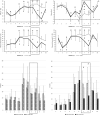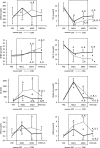Effects of 36-hour recovery on marksmanship and hormone concentrations during strenuous winter military survival training
- PMID: 37596657
- PMCID: PMC10439591
- DOI: 10.1186/s13102-023-00711-6
Effects of 36-hour recovery on marksmanship and hormone concentrations during strenuous winter military survival training
Abstract
Objectives: Survival training can provide a unique setting for scientific examination of human stress responses and physical performance in a realistic operational military context. The aim of the present study was to observe effects of a 36-h recovery period on serum hormone concentrations, salivary cortisol, and marksmanship during 10-day winter military survival training in north of the Arctic Circle.
Design and methods: Sixty-eight male soldiers were randomly divided into two groups; EXP (n = 26) and CON (n = 42). While CON performed the whole exercise phase in the field, EXP had 36-h recovery period between days 6 and 8. Several hormones were measured during the study to investigate recovery.
Results: Subjective physical and mental demand as well as catabolic hormone levels increased and anabolic hormones decreased in CON (p < 0.05), whereas in EXP, recovery period attenuated negative effects of survival training. Prone shooting performance decreased (87.5 ± 6.5 vs. 76.3 ± 8.8, points out of 100, p < 0.05) between days 6 and 8 in CON while EXP was able to maintain shooting performance throughout the study.
Conclusion: A short recovery during a strenuous training can prevent the degradation in psychophysiological state and shooting performance in soldiers, which can be crucial for survival in demanding operational winter environment. In the present study, 36-h rest period during the field training seems to enhance recovery but the duration of the period was inadequate for full recovery from the accumulated operative stress. In conclusion, appropriate recovery periods should be implemented in order to optimize occupational performance during high operative stress.
Keywords: Arctic; Endocrinology; SERE; Soldier.
© 2023. BioMed Central Ltd., part of Springer Nature.
Conflict of interest statement
The authors declare they have no competing interests.
Figures



Similar articles
-
Neuromuscular Performance and Hormonal Profile During Military Training and Subsequent Recovery Period.Mil Med. 2019 Mar 1;184(3-4):e113-e119. doi: 10.1093/milmed/usy176. Mil Med. 2019. PMID: 30053107
-
Effect of Prolonged Military Field Training on Neuromuscular and Hormonal Responses and Shooting Performance in Warfighters.Mil Med. 2018 Nov 1;183(11-12):e705-e712. doi: 10.1093/milmed/usy122. Mil Med. 2018. PMID: 29860348
-
Energy Balance, Hormonal Status, and Military Performance in Strenuous Winter Training.Int J Environ Res Public Health. 2023 Feb 24;20(5):4086. doi: 10.3390/ijerph20054086. Int J Environ Res Public Health. 2023. PMID: 36901097 Free PMC article.
-
Acute Fatigue Responses to Occupational Training in Military Personnel: A Systematic Review and Meta-Analysis.Mil Med. 2023 May 16;188(5-6):969-977. doi: 10.1093/milmed/usac144. Mil Med. 2023. PMID: 35639912 Free PMC article.
-
Blood hormones as markers of training stress and overtraining.Sports Med. 1995 Oct;20(4):251-76. doi: 10.2165/00007256-199520040-00004. Sports Med. 1995. PMID: 8584849 Review.
References
LinkOut - more resources
Full Text Sources

